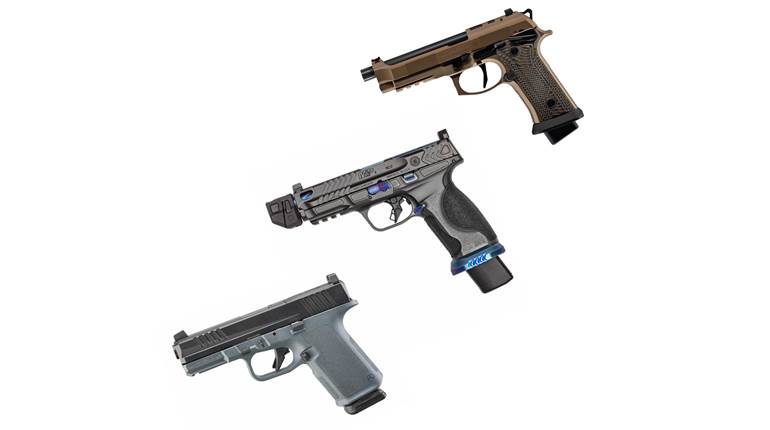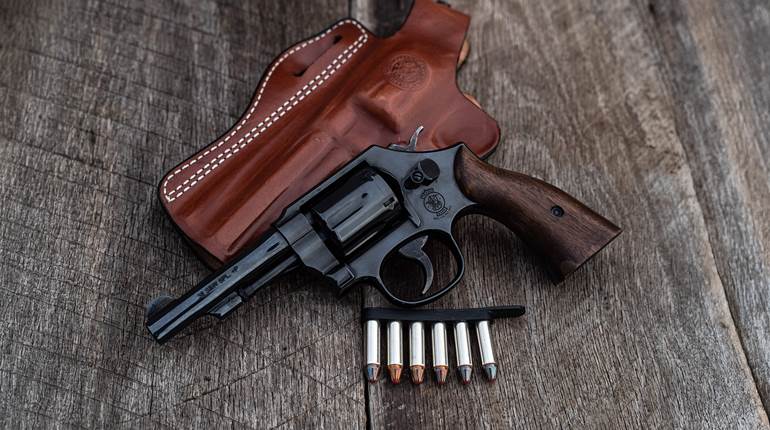
Top image courtesy Colt.com
Colt—the name has stood for great firearms for nearly two centuries. From the first Paterson revolver of 1837 to the M16 rifle, millions of people have bought, bartered or stolen to acquire a Colt gun. With its long and storied history Colt conjures up a plethora of images at the mention of the name. Some wax nostalgic over the elegant cap-and-ball revolver models of 1836, ’51 and ’60. Others lean toward the notion that pistol development reached its pinnacle with the Browning-designed 1911. Still others get giddy over the gorgeous Python. But there is no doubt that the one gun that has defined Colt for some 144 years is the Model 1873 Single Action Army (SAA) revolver, a.k.a Model P or Peacemaker. Twice the company has tried to jettison this revolver and focus its business on more modern arms, and thrice the demand from people from all over the world has compelled Colt to bring the SAA back into production. 
Many incorrectly credit Samuel Colt with inventing the revolver, citing the well-known tale of his time aboard the ship Corgo on a voyage to Calcutta where he observed the ship’s wheel could be locked into position via a capstan on the spokes. It is on that voyage that the 16-year-old seaman carved a wooden prototype of a pepperbox revolver. However, the revolver was actually first invented in the late 16th century in Europe and was nothing more than expensive curiosity. What Colt did is take the concept and figure out how to manufacture it into a workable firearm. He was also the one who first made the use of interchangeable parts a practical reality in the manufacturing process. Colt died in 1862 of complications of gout. His net worth at the time of his death was about $15 million—about $350 million in today’s dollars—and though his company had gone through several fits and spurts, the percussion revolvers made under the Colt name were used by militaries, lawmen, outlaws and citizens throughout the world.

Image by author
In 1849 Rollin White went to work for Colt making revolver barrels one at a time on a lathe. While working at Colt he came up with the idea of a bored-through cylinder that could be loaded from the breech. In the meantime Colt had put White under contract to manufacture the lockworks of revolvers. Colt was reportedly more concerned with marketing its revolvers than improving them. When White attempted to pursue an improvement on the Colt design he was summarily fired. In 1855 White patented his bore-through cylinder design. Though White’s patent was an ultimately futile attempt to improve on the cap-and-ball concept, Smith & Wesson realized that the bored-through cylinder deign would be necessary to allow the use of a self-contained, breech-loading cartridge. A year later White signed an exclusive agreement with rival Smith & Wesson to manufacture the first cartridge repeating revolvers.
Colt could not work on a bored-through cylinder for its revolvers without paying arch competitor S&W a royalty until 1869. During this time Colt engineers William Mason and Charles Richards put forth some conversion concepts resulting in the 1871-72 Open Top revolver chambered in .44 Henry rimfire. Colt submitted the revolver to the army for testing, but it was rejected. The army wanted a more powerful cartridge and a more robust revolver than an open-top. Mason is credited with adding the topstrap to the design.
Concurrently Colt and the Union Metallic Cartridge Co. were developing a new cartridge that had more power than anything produced thus far. This new cartridge featured an inside-lubricated bullet that would not pick up dirt and grit in the field. The bullet was a .454-caliber weighing 255 grains and powered by 40 grains of black powder. It also featured a centerfire primer, a concept developed in 1855 and perfected by several inventors, including Col. Edward Mounier Boxer, a British artillery officer. The cartridge, .45 Colt, was chambered in the new revolver and submitted to the army in 1872. The army accepted both the revolver and the cartridge, and production began in 1873.

Image courtesy Colt.com
The SAA was an instant success, and civilians as well as the military clamored for the robust sidearm. Barrel lengths were 4 3/4" (often referred to as Gunfighter), 5 1/2"(a.k.a Artillery) and 7 1/2" (Cavalry or standard). Initially the frame and hammer were color casehardened with the remainder of the metal parts deeply blued. Stocks were either walnut or black hard rubber. Sights consisted of a blade front and a groove in the topstrap for the rear.
Its cylinder held six cartridges, but those who carried one daily soon learned to carry five cartridges with the hammer down on an empty chamber. There is no hammer or firing pin block on an SAA so the pin would rest directly on the primer of a cartridge under it, thus making the real possibility of an accidental blow to the hammer or dropping of the gun resulting in something perforated that was never intended to be perforated. The correct method to load an SAA, by the way, is to bring the hammer to half-cock to free the cylinder, load one cartridge, skip one cylinder and load the remaining four. Then bring the hammer to full cock—this is important—and lower it onto the empty chamber. Loading this way ensures the hammer will always be on an empty chamber and should prevent the user from looking at the front of the cylinder with the barrel pointed at his head to see bullet noses. Too, lowering the hammer from half-cock to its resting position does not allow the locking bolt to register in a cylinder notch. Not only is this not a safe way to pack the gun, it wears an unsightly groove in the cylinder.

Image courtesy Colt.com
As Colt developed the SAA, Winchester also came out with an improved lever-action rifle that was introduced at the same time. The 1873 Winchester was chambered in an equally new center-fire cartridge developed by Winchester, the .44-40 Winchester Center Fire. Cowboys, frontiersmen, settlers and explorers of the west decided it would be real handy to have a rifle and six-gun chambered in identical cartridges, so in 1877 the first SAA was chambered in the Winchester round. It was called the Frontier Six-Shooter. Eventually the revolver would be chambered in some 36 different cartridges ranging from .22 LR to .476 Eley and including the .44 Magnum (very few—I’ve heard of just two examples).
Collectors have divvied the SAA into three generations. First-generation SAAs (1873 – 1941) were initially made with iron frames that were color casehardened to withstand the higher pressures of the cartridges that were being developed. They also have removable bushings in the cylinder that support the base pin. Up until 1896 the base pin latch was retained by a screw. After serial number 164,100 the base pin latch was spring loaded. Four years later steel metallurgy had improved to the point that Colt certified the SAA capable of being used with smokeless powder. Today a relic, non-shooting example of a first-gen SAA will fetch as much as $8,000, and a near 100-percent sample will go for somewhere north of 50 grand. Those with historical provenance…well, the sky is the limit.
Colt first attempted to retire the SAA after World War II. The tooling was pretty much worn out, and the company wanted to focus on more modern designs. That made perfect sense until television renewed the interest in cowboys and rugged frontiersmen ways of life. An upstart by the name of Bill Ruger brought out a close copy of the SAA called the Blackhawk and began selling the pants off of Colt. Jumping like a gut-shot grizzly, Colt quickly retooled and brought out the Second-generation SAA in 1956. Second-generation guns had some smaller improvements in manufacturing but are nearly identical to the first-generation guns. The hammers on second-generation revolvers are blued with polished white sides. Numerous variations including the long-barreled Buntline—cashing in on the television show “The Life and Legend of Wyatt Earp,” starring the recently departed Hugh O’Brien—Sheriff’s model and an adjustable sighted New Frontier model in 1961 were produced. By 1974 interest had waned again and Colt decided to cease further manufacture.
The shooting public would have no such nonsense regarding a favorite, though. Enough of us sunk the spurs into Colt to cause it to rethink that decision and in 1976 the third-generation SAA was brought out. Third-generation SAAs have a solid cylinder bushing press fitted to the cylinder and a different thread pitch for the barrel and frame. Though not the hot seller that modern polymer semi-autos are, the demand remains steady for the iconic SAA.
When it was first introduced the SAA could be bought with a $20 gold piece. The price is nearly the same. Today the MSRP of a Colt SAA is $1,499 for a blue model; $1,699 for an all-nickel-plated gun—which is about the same spot price for an ounce of gold.
Volumes have been written on the SAA—no surprise since anything that has been so much a part of a civilization for nearly a century and a half is bound to have had every nuance of it examined. It has been the tool of cavalrymen, cowboys, lawmen and outlaws. Whether used to protect and defend, an ersatz hammer to pound fence staples or as a movie star, the Colt Single Action Army has delivered every time. Rusty relic or pristine safe queen the SAA carries with it an elegance and panache few manmade objects could command.






































